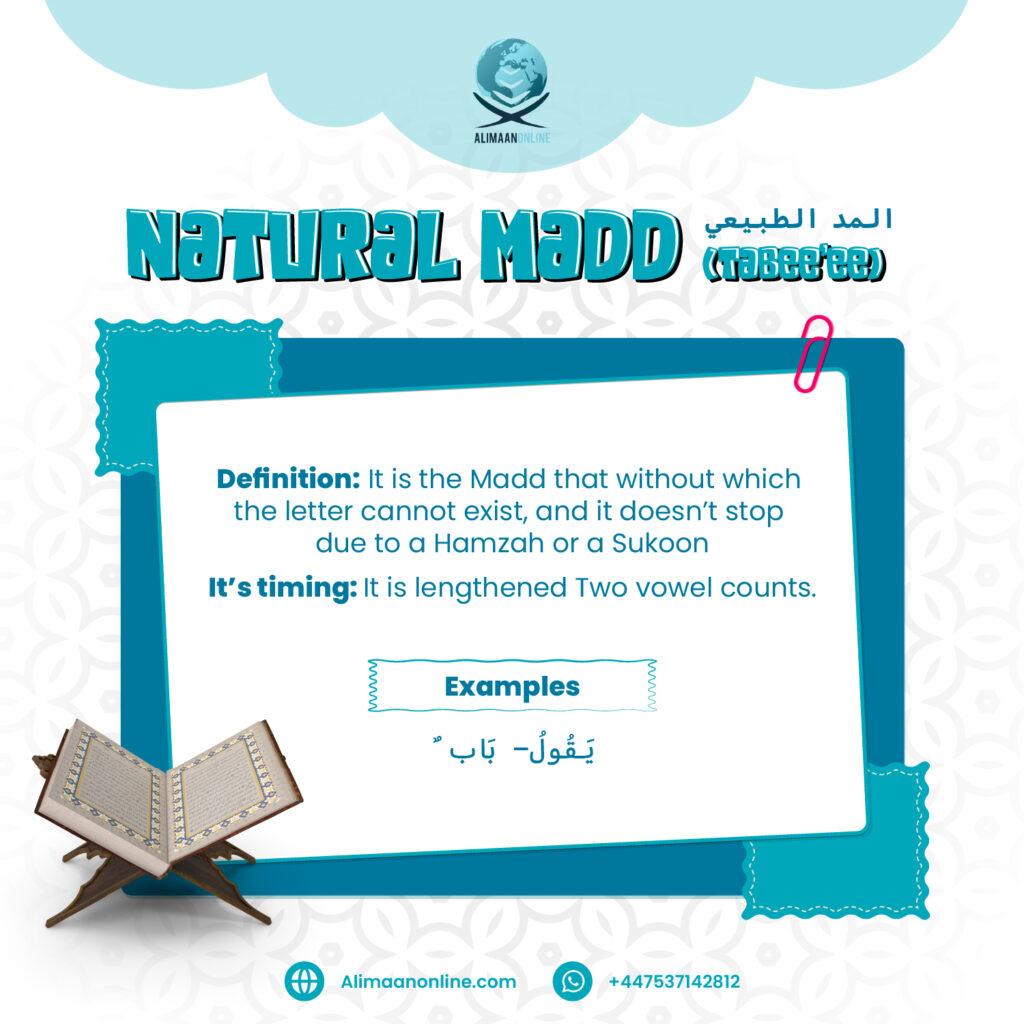In the domain of Tajweed, mastering the intricacies of Madd Tabee’ee is pivotal for those aspiring to achieve excellence in Quranic recitation. Madd Tabee’ee, a fundamental aspect of Tajweed, governs the elongation of specific vowel sounds within the Quranic text. Understanding its principles and applying them accurately not only enhances the beauty and rhythm of recitation but also ensures the preservation of the Quran’s pristine message. Therefore, delving into the nuances of Madd Tabee’ee is indispensable for anyone committed to the art of Quranic recitation.
What’s Madd Tabee’ee (Natural Madd)?
Known as Natural Madd, this principle stands as a fundamental in Tajweed. It involves the innate elongation of vowel sounds in Arabic letters when they are succeeded by a Madd letter (Alif, Waw, or Ya). Typically, this elongation extends the sound for two Harakat (beats or units of time). Madd Tabee’ee is considered the simplest form of Madd, yet it is an indispensable aspect of proper Quranic recitation, enriching the spoken word with melody and clarity.
Natural Madd:
Definition:
Madd Asli is a type of prolongation inherent to certain letters, without which those letters cannot exist. It occurs when any of the three elongation letters (Alif, Waw, or Ya) is preceded by a hamza or sukoon.
Length:
Madd Asli extends for two harakahs. A harakah is the duration of opening one of the fingers after making the closed fist, and two harakahs represent the time it takes to open two fingers, one after another.
Reason for Name:
Madd Asli earns its name because it lacks causes for secondary prolongations, it occurs naturally in Arabic without external influence, it has a consistent duration of only two harakahs, and its pronunciation solely defines the entity of the letter of prolongation. Additionally, it’s termed “Madd Tabee” (natural) because it’s naturally prolonged for only two harakahs, neither more nor less than this.
Madd Letters:
Madd Letters in Arabic Tajweed encompass the practice of prolonging vowel sounds, facilitated by specific letters categorized into Leen and Huroof Maddiyyah:
- Alif Saakin (ا): After a Fatha, it stretches the ‘a’ sound, resulting in a clear and extended ‘aa’ sound.
- Waaoo Saakin (و): When following a Dammah, it elongates the ‘u’ sound, producing a deeper ‘uu’ sound.
- Yaa Saakin (ي): After a Kasrah, it lengthens the ‘i’ sound into a longer ‘ii’.
Conditions for Madd Tabee’ee: Criteria for Application
Madd Tabee manifests under distinct conditions:
1. Presence of a Madd Letter: A Madd letter (Alif, Waaw, Yaa) must be present within the word.
2. Corresponding Vowel Marker:The Madd letter should directly precede its associated short vowel marker (Fatha for Alif, Dammah for Waaw, Kasrah for Yaa).
3. Absence of Sukoon or Shaddah: The Madd letter should not be succeeded by a Sukoon or a Shaddah.
Examples of Madd Tabee’ee:
1. َقَال (Qaala) – The Alif after the Fatha on ق extends the ‘a’ sound.
2. مُوسَى (Moosaa) – The Waw after the Dammah on م elongates the ‘oo’ sound.
3. قَرِيبًا (Qareeban) – The Ya after the Kasra on ق prolongs the ‘ee’ sound.
How to Identify and Practice Madd Tabee’ee?
Recognizing Madd Tabee’ee in Quranic Text
Identifying Madd Tabee’ee necessitates comprehension of its principles and spotting its cues in the text. Here are steps and tips for identifying Madd Tabee:
1. Look for Madd Letters: Identify the three Madd letters (Alif – ا, Waaw – و, and Yaa – ي) within the Quranic text.
2. Check for Preceding Vowel Marker: Ensure the Madd letter is preceded by the corresponding short vowel (Fatha for Alif, Dammah for Waaw, and Kasrah for Yaa).
3. Confirm Absence of Sukoon or Shaddah: Verify that the Madd letter is not succeeded by a Sukoon or Shaddah, as these indicators alter the elongation rules.
4. Utilize Color-Coded Quran: Some Qurans are color-coded to denote Tajweed rules, including Madd Tabee, facilitating easier identification and practice.
Tips for Practicing Madd Tabee’ee
1. Start with Short Surahs: Initiate your practice with shorter Surahs or verses where Madd Tabee occurs frequently. This helps in becoming familiar with its application gradually.
2. Listen to Expert Recitations:Immerse yourself in recitations by proficient Qaris to grasp the natural and fluent application of Madd Tabee. Observation aids in understanding its nuances.
3. Recite Slowly and Clearly:Practice reciting slowly, paying close attention to elongating the Madd letters appropriately. As confidence builds, gradually increase your pace while maintaining clarity.
4. Use Mnemonics:Create mnemonic devices or memory aids to remember the conditions and duration of elongation for each Madd letter. Mnemonics can aid in retention and recall during practice.
5. Seek Feedback:Recite in the presence of a knowledgeable teacher or utilize digital apps offering Tajweed feedback. Constructive criticism helps in correcting errors and refining your recitation skills.
The Significance of Madd Tabee in Tajweed: Enhancing Quranic Recitation
Madd Tabee holds immense importance within Tajweed, profoundly shaping the Quranic recitation. Here’s why it’s crucial:
Ensures Pronunciation Accuracy:
Madd Tabee establishes guidelines for elongating vowel sounds, pivotal for precise pronunciation. This accuracy safeguards against misinterpretations that could distort meanings, thus preserving the integrity of the Quranic text.
Preserves the Original Text:
Given the Quran’s oral transmission, adherence to Madd Tabee’s principles becomes indispensable for maintaining the original pronunciation and content. It serves as a guardian of the Quran’s authenticity across generations.
Facilitates Smooth Recitation:
By delineating the methods and instances of elongation, Madd Tabee contributes to a seamless recitation flow. This clarity enhances the listener’s engagement and comprehension, enriching the recitation experience.
Maintaining Meaning through Elongation
Precision in Meaning:
The precise duration of vowel elongation holds significant weight in Arabic, capable of altering meanings. Madd Tabee’s regulations standardize this length, preserving the intended meanings within the Quran.
Avoiding Misinterpretations:
Adherence to Madd Tabee’s rules consistently safeguards against misinterpretations, ensuring the faithful transmission of the divine message. This steadfast application mitigates the risk of misunderstandings, upholding the Quran’s clarity and integrity.
The Importance of Applying Madd Tabee’ee
Applying Madd Tabee is crucial for several reasons:
1. Pronunciation Precision:Madd Tabee ensures accurate pronunciation by standardizing the elongation of vowel sounds, preserving the intended meanings of Quranic verses.
2.Maintaining Rhythmic Flow:By adhering to Madd Tabee rules, reciters can maintain a smooth and rhythmic flow in their recitation, enhancing the overall aesthetic and spiritual experience.
3. Preserving Authenticity:Consistent application of Madd Tabee helps in preserving the authenticity of the Quranic text, ensuring its transmission remains faithful to its original form.
4. Enhancing Listener Engagement:A recitation with proper application of Madd Tabee is more engaging to listeners, captivating their attention through its melodic and rhythmic qualities.

